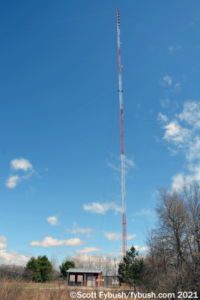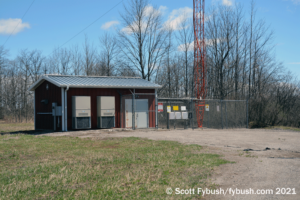Site of the Week 11/5/2021: New York’s Mohawk Valley
Text and photos by SCOTT FYBUSH
There are few areas in the Northeast with as linear a concentration of population as the Mohawk Valley of eastern New York. For centuries, the narrow east-west gap between the Adirondack Mountains to the north and the Catskills to the south has been the path for commerce and development from the Hudson River westward into the Great Lakes – first along the Mohawk River, then the Erie Canal that paralleled it, then the New York Central railroad and now the New York Thruway, all within a few miles of each other along the strand from Albany to Utica.




We’ve driven it hundreds of times, taken the train more than a few times, but somehow had never really made the time to see some of the valley’s towers until we had the chance in early 2021 to get a quick look inside one of its stations.
WVTL (1570) is one of two AMs in Amsterdam, the small city at the east end of the valley just before it opens up into the larger Albany metro, and for its entire existence it’s transmitted from the same spot on Route 30 just two miles south of the Thruway, the river and the railroad.




The 1570 signal first went on here in 1961 as WAFS (it was actually a two-tower directional for a little while before going non-D in 1966), then became WKOL in 1967, the calls it used for much of its existence.
Under current owner Ken Roser, 1570 went country as “Bug Country” WBUG, and for the last few years it’s migrated to AC and then back to classic country under its current identity as WVTL. Most recently, it’s been operated entirely automated, running from Roser’s main studios in Utica, so there wasn’t that much to see inside the building when we stopped by.




A lobby/office area on one side of the building connects to the studio area on the left side, with a main studio and a news studio facing the parking lot and Route 30, another small office area behind, and then half a flight of stairs leading down to the original transmitter building in back. (For most of WAFS and WKOL’s existence, the studios were in or near downtown Amsterdam, across the river to the north.)
The transmitter room has an older Harris transmitter (which replaced the original Collins), a newer rack-mounted Armstrong, and an even newer rack of equipment for WVTL’s FM translator on 104.7, W284BZ.






The translator antennas sit out back on the top of the AM tower, which was just recently rebuilt to replace the original 1961 stick; they’re quite directional to the west to protect stations on 104.5 and 104.9 to the east in the Albany-Schenectady-Troy market.




You can hear most of that market’s bigger signals just fine here in Amsterdam, and it’s probably no surprise that the lone commercial-band FM signal from Amsterdam now rimshots Albany.
That’s WEXT (97.7), which these days operates as a noncommercial AAA station run by public broadcaster WMHT. (We saw its studios in Troy a few years ago here in this space.)
What’s now WEXT started in 1975 as WCSS-FM, sister to Amsterdam’s oldest AM, WCSS (1490), and it initially operated from a site a few miles to the north near Broadalbin. It was later known as WMVQ, then picked up the WKOL calls for a few years, then went classical as WBKK after being sold to WMHT in 1994. By then, it had moved to Route 30 north of Amsterdam, on a tall tower built for a new UHF TV station on channel 55.


The new WOCD was an independent rimshot into Albany, competing against two other closer UHF signals, and it eventually ended up as the market’s Pax/Ion station, WYPX. (It now operates from the main Helderbergs Mountain tower farm south of Schenectady, on the tower that was originally used by WMHT-TV/FM, so now it’s just WEXT on its little side-mounted antenna here.)
Back to WCSS: the AM side of the operation has been around since 1948, and it’s never moved from its original site, where Upper Locust Ave. meets Midline Ave. on the north side of Amsterdam, where the city rises up sharply from the river up into the Adirondack foothills.
These days, there’s a translator here, too, W295CZ (106.9), mounted at the top of the tower. (WCSS is part of Cranesville Block Company’s little network of stations in the valley, which include simulcaster WKAJ 1120 to the west in St. Johnsville and WIZR 930 in the middle, in nearby Johnstown, as well as a tiny FM way up in the Adirondacks, WYVS 96.5 Speculator.)


Let’s keep moving west, shall we? We take the side roads up in the hills to get to Johnstown and adjoining Gloversville, where we’ve stopped in before at WENT (1340) and its translator on 105.1, still operating from studio and transmitter on Harrison Street Extension next to the Route 30A bypass. (Just recently, the owners of WENT signed a deal to buy WVTL from the Roser group, creating a second duopoly in the area to match Cranesville’s WIZR/WCSS.)
While the AMs around here are all easy to get to, right in the towns along the Thruway and the river, the FMs are up in the hills – but it’s a nice sunny day, the roads are dry, we’ve got plenty of time, so off we go. West of Johnstown and a few miles north of the river, Indian Road near Sammonsville takes us up to the 350-foot tower of what’s now Townsquare’s WQSH (103.5 St. Johnsville).
This was one of the biggest drop-in signals of the 1980s, a full class B that started in 1986 as WITU, an FM sister to WSCM (1190). Both were licensed to Cobleskill, 20 miles to the south of the FM site up here in the hills. Within a few years, 103.5 was sold to become an Albany simulcast, initially as WSHQ, half of “Sho FM” along with WSHZ (98.3 Rotterdam), creating a signal that could be clearly heard everywhere from Albany to Utica. After 98.3 became part of the Jacor/Clear Channel cluster, 103.5 was spun off to Regent (now Townsquare), which used it for years as WQBJ, simulcasting rocker WQBK (103.9 Rensselaer)






More recently, Townsquare has shuffled those simulcasts – for a while, WQBJ on 103.5 was doing modern rock as “Alt 103.5,” one of two competing stations in the market calling itself “Alt,” and even more recently, 103.5 has taken the WQSH calls, now simulcasting with Townsquare’s 105.7 in the Albany market (itself formerly WQSH and now WQBK) as rock “Q105.7/103.5,” again with two signals that together are usable from Albany all the way to Utica.


Back down by the river, we go across on Route 10 to get to the Thruway and head home – but first, we make one more trip uphill to get a closer look at a station we’ve seen for decades, but only from a distance.
When Albany public broadcaster WAMC (90.3) began its regional expansion in the late 1980s, one of the first directions it looked in was the Mohawk Valley. WCAN (93.3 Canajoharie) hit the air in the spring of 1988, followed quickly by WAMK in Kingston and then a dozen more full-power stations and a bunch of translators that now carry WAMC to parts of four states, all the way from the New York City exurbs to the Canadian border.
But it was WCAN that came first, and it’s been here all along, up the twisty streets of Canajoharie (a village best known for the Beech-Nut factory that sat for decades along the river) and then uphill to Seebers Lane, where WCAN’s tower shares a little hilltop with a cable TV headend.




OK, I lied – there was still plenty of blue sky and daylight, so we didn’t really head straight for home after carefully edging the car back down the hill from WCAN. From Canajoharie, we cross the line into the fringes of the Utica market, and we’ll show you some updates from there in next week’s installment.
Thanks to Ken and Grant Roser for the tour!
THE 2025 TOWER SITE CALENDAR IS SHIPPING NOW!
Behold, the 2025 calendar!
We chose the 100,000-watt transmitter of the Voice Of America in Marathon, right in the heart of the Florida Keys. This picture has everything we like in our covers — blue skies, greenery, water, and of course, towers! The history behind this site is a draw, too.
Other months feature some of our favorite images from years past, including some Canadian stations and several stations celebrating their centennials (can you guess? you don’t have to if you buy the calendar!).
We will ship daily through Christmas Eve. Place your order now for immediate shipping!
This will be the 24th edition of the world-famous Tower Site Calendar, and your support will determine whether it will be the final edition.
It’s been a complicated few years here, and as we finish up production of the new edition, we’re considering the future of this staple of radio walls everywhere as we evaluate our workload going forward.
The proceeds from the calendar help sustain the reporting that we do on the broadcast industry here at Fybush Media, so your purchases matter a lot to us here – and if that matters to you, now’s the time to show that support with an order of the new Tower Site Calendar. (And we have the new Broadcast Historian’s Calendar for 2025 ready to ship, too. Why not order both?)
Visit the Fybush Media Store and place your order now for the next calendar, get a great discount on previous calendars, and check out our selection of books and videos, too!
And don’t miss a big batch of Mohawk Valley IDs next Wednesday, over at our sister site, TopHour.com!
Next week: What’s New in Utica


